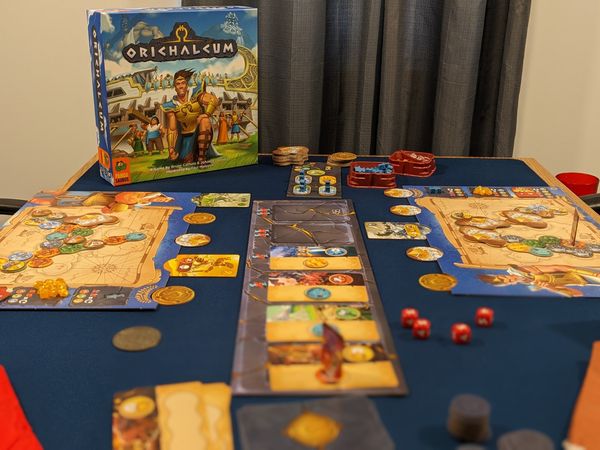Orichalcum – The Tabletop Times Review

Orichalcum is a 1-4 player (there is also an official solo mode available to download from BGG), light 4X game published by Pandasaurus Games (in the US) with action drafting, tile placement, and dice rolling to fight Creatures!
![]()
![]()
![]() Mechanics
Mechanics ![]()
![]()
![]()
A game of Orichalcum goes until a player reaches 5 points, at which point the game ends immediately and that player is the winner.
![]() Construct an Orichalcum medallion by taking a Construct action and turning in 5 orichalcum nuggets.
Construct an Orichalcum medallion by taking a Construct action and turning in 5 orichalcum nuggets.
![]() Construct a Temple by taking Construct action and placing a Temple tile on 4 adjacent terrain circles of different types in a diamond shape on your player board. You cannot construct a Temple next to a Monster.
Construct a Temple by taking Construct action and placing a Temple tile on 4 adjacent terrain circles of different types in a diamond shape on your player board. You cannot construct a Temple next to a Monster.
![]() Gain a Titan by creating a group of 3 (or more) circles of the same terrain type adjacent to each other. These are temporary points as the Titan can move to another player if they make a 3 (or more) grouping of the same terrain type circles. You can only have one Titan unless you have a building that says otherwise.
Gain a Titan by creating a group of 3 (or more) circles of the same terrain type adjacent to each other. These are temporary points as the Titan can move to another player if they make a 3 (or more) grouping of the same terrain type circles. You can only have one Titan unless you have a building that says otherwise.
A round is played in turns with each player completing 4 phases.
![]() Draft an Action card from the Action board (Mandatory)
Draft an Action card from the Action board (Mandatory)
![]() Place the tile that came with the Action card you chose on your player board following placement rules (Mandatory)
Place the tile that came with the Action card you chose on your player board following placement rules (Mandatory)
![]() Resolve the Action card (Optional)
Resolve the Action card (Optional)
![]() Pay resources to perform an additional Action (Optional)
Pay resources to perform an additional Action (Optional)
In a 2 player game, the first player will discard an Action card from the Action board before the next player chooses a card.
Each Action card will have 1 of 4 action icons on it. The 4 actions that appear on the Action cards are:
![]() Produce orichalcum – gain an orichalcum for each orichalcum mine on your board
Produce orichalcum – gain an orichalcum for each orichalcum mine on your board
![]() Produce hoplites – gain a hoplite for each training center on your board
Produce hoplites – gain a hoplite for each training center on your board
![]() Capture Creatures
Capture Creatures
![]() Construct
Construct
There are 5 different types of terrain circles: Mountain, Forest, Desert, Lagoon, and Volcano (which will spawn monsters and is a wild for constructing Temples).
When you capture a creature you can assign hoplites from your supply to that creature and roll dice equal to 1 + the number of hoplites you assigned. If you roll a skull, or if the sum of the roll is equal to at least the number that is featured on the creature card, you capture that creature. Collect the reward that is pictured on the creature and put the creature standee in your captured creature area on your player board.
![]()
![]()
![]() Thoughts
Thoughts ![]()
![]()
![]()
![]() Kim
Kim ![]()
I first heard about Orichalcum in a Game Trade Magazine and my interest was piqued because it was described as a light 4X game. While we own several 4X games, we have yet to play them, mostly because we play a lot at 2 and 4X games usually flourish with higher player counts. While I was eager to try it, I was worried that it would be too light and not offer enough strategy, but I was wrong!
I really enjoy Orichalcum, it offers a good amount of strategy and the two sides of the boards help keep the game variable. It also plays very fast for the amount of strategy it offers. 2 player games take us around 40 minutes. There’s not a lot of downtime between turns, which is great. My only complaint, which may be minor and a personal preference, is that since turns are so quick the upkeep is a bit fiddly for two players. It seems like it takes almost as much time to flip new Action cards, add tiles to the cards, and assign monsters as the amount of time it takes to take my turn. Again, this is not that big a deal and I will note the more times we played it, the smoother we found the process.
![]() Devin
Devin ![]()
From my experience with Pandasaurus as a publisher (or Catch-Up Games, whichever has a heavier hand in these globally-published titles), I’ve always been satisfied with the component quality, colorful art, and price point. Orichalcum is no different. The art is bold and engaging, and while the terrain types use color as an indicator, they also have unique art that makes them colorblind-friendly. (![]() EDIT:
EDIT:![]() I have been informed that the cloth bag that the creatures are in during play is large enough to hold them with their standees on, so there is no need to ever remove their plastic base. The following concerns are not really valid in that case, but I’m leaving them in since they were in the original post.) My only concern may be that the repeated slotting of the creatures into their standees could wear their cardboard chits out over time, but that wouldn’t be a game-breaking occurrence, anyway. In a worst-case scenario, we could just lay the creature chits down instead of standing them up.
I have been informed that the cloth bag that the creatures are in during play is large enough to hold them with their standees on, so there is no need to ever remove their plastic base. The following concerns are not really valid in that case, but I’m leaving them in since they were in the original post.) My only concern may be that the repeated slotting of the creatures into their standees could wear their cardboard chits out over time, but that wouldn’t be a game-breaking occurrence, anyway. In a worst-case scenario, we could just lay the creature chits down instead of standing them up.
For English players, it may be apparent that the rulebook has been translated from French. Some of the sentence structure and word choice may seem a little odd, but overall, the rules are clear and explicit on how to play the game. We were able to read through the book and get to playing quickly without checking the rules much. There were only two cases of rules ambiguity that we came across:
![]() Resources are intended to be limitless. If you run out of a resource, use a substitute to keep track.
Resources are intended to be limitless. If you run out of a resource, use a substitute to keep track.
![]() When placing a new terrain tile, one of the placement rules requires it to be placed next to an existing terrain tile. Later in the book, a statement about buildings says that they no longer count as terrain. In this case a terrain tile is not the same thing as terrain. You can place new terrain tiles adjacent to tiles with buildings on them.
When placing a new terrain tile, one of the placement rules requires it to be placed next to an existing terrain tile. Later in the book, a statement about buildings says that they no longer count as terrain. In this case a terrain tile is not the same thing as terrain. You can place new terrain tiles adjacent to tiles with buildings on them.
As for the gameplay itself, it’s fun! In my mind, 4X games usually place a lot of emphasis on the ‘exterminate’ part and involve a lot of player-versus-player interaction. This is not the case in Orichalcum. While you may aim to remove tiles or buildings that your opponent may need, you never directly impact each other’s islands. I think this helps Orichalcum since it’s a lighter game. Players can get a taste of the 4X experience without the combativeness that is usually inherent in the genre. The tile-placement puzzle and various scoring routes can lead to some very interesting decision points as you weigh your options for the most benefit, and long-term strategy definitely feels possible even with the randomization of the actions and tiles every round.
Written by Kim Gonzales & Devin Skelton, writers from The Tabletop Times

